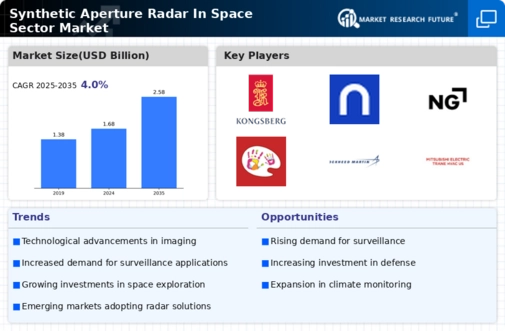Technological Advancements
The Global Synthetic Aperture Radar In Space Sector Market Industry is experiencing rapid technological advancements that enhance the capabilities of radar systems. Innovations in signal processing, antenna design, and data analytics are leading to improved image resolution and accuracy. For instance, the integration of artificial intelligence and machine learning algorithms is enabling more efficient data interpretation, which is crucial for applications in agriculture, urban planning, and disaster management. As these technologies evolve, they are likely to drive the market's growth, contributing to an estimated market value of 1.68 USD Billion in 2024, with projections indicating a rise to 2.58 USD Billion by 2035.
Market Charts and Projections
Government Initiatives and Funding
Government initiatives and funding play a pivotal role in the Global Synthetic Aperture Radar In Space Sector Market Industry. Various countries are investing in satellite programs to enhance their Earth observation capabilities. For example, the European Space Agency and NASA have launched multiple missions focused on radar technology to monitor climate change and natural disasters. These investments not only bolster national security but also promote scientific research and environmental sustainability. As governments continue to prioritize space technology, the market is likely to benefit from increased funding and support, further driving its growth.
Increasing Demand for Earth Observation
The demand for Earth observation data is a significant driver for the Global Synthetic Aperture Radar In Space Sector Market Industry. Governments and organizations worldwide are increasingly relying on satellite imagery for various applications, including environmental monitoring, resource management, and national security. The ability of synthetic aperture radar to provide high-resolution images regardless of weather conditions or daylight enhances its appeal. This growing reliance on satellite data is expected to contribute to a compound annual growth rate of 3.97% from 2025 to 2035, reflecting the market's potential to meet the needs of diverse sectors.
Growing Applications in Defense and Security
The defense and security sector is a major contributor to the Global Synthetic Aperture Radar In Space Sector Market Industry. Synthetic aperture radar systems are utilized for reconnaissance, surveillance, and target acquisition, providing critical data for military operations. The ability to gather high-resolution imagery in all weather conditions makes these systems invaluable for defense agencies. As geopolitical tensions rise, the demand for advanced radar technology is expected to increase, further propelling market growth. This trend underscores the strategic importance of synthetic aperture radar in national defense strategies globally.





















